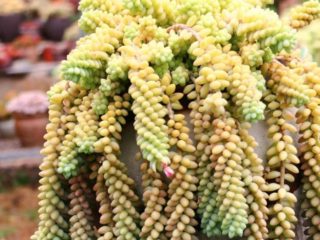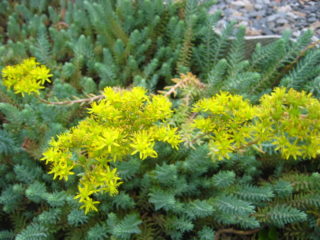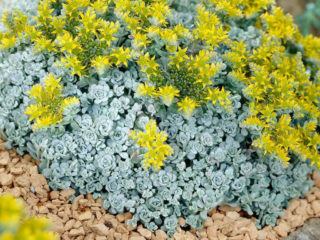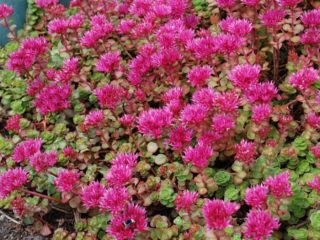Content
Kamchatka sedum or sedum is a plant that belongs to the genus of succulent crops. The scientific name comes from the Latin word sedare (to pacify) for its pain-relieving properties, or from sedere (to sit) because many species of this plant are spread on the ground. As for the Russian name, it comes from the Ukrainian word "cleaning". The distribution area of this culture is quite wide; it can be found in Africa, America, Eurasia.
Description stonecrop of Kamchatka

Kamchatka sedum looks very impressive in garden plots
Sedum Kamchatka is a perennial or biennial plant, it can be herbaceous, shrub or semi-shrub. Likes to grow on dry slopes, meadows.
Appearance in thick, fleshy leaves. They are devoid of petioles and are painted in a wide variety of colors - from deep greens to reds. It is noteworthy that the color of stonecrop depends not only on the type of plant, but also on the influence of the environment, on the place of growth. Those specimens that receive more sunlight have brighter hues. The presence of reddish streaks on the leaves indicates the special composition of the soil. There are plant varieties of cylindrical, oval, round shapes.
Sedum Kamchatka blooms very beautifully. Small buds form umbellate inflorescences of white, blue, pink and yellow. They are not devoid of aroma, and rather persistent. For many varieties, flowering begins in the second half of summer, closer to autumn. Another feature is the ability to grow quickly, thanks to a well-branched stem.
The composition of Kamchatka stonecrop includes many useful substances:
- alkaloids;
- coumarins;
- flavonoids;
- tannins;
- glycosides.
In addition, the composition contains vitamins, especially the high content of ascorbic acid. Due to its rich composition, sedum is widely used in folk medicine as an analgesic, anti-inflammatory, diuretic, laxative, tonic.
Sedum varieties of Kamchatka
There are more than 500 varieties of sedum, many of which are not cultivated and grow in natural conditions. Each variety has its own merits and is in demand among many gardeners, despite the fact that the culture can hardly be called beautiful. However, true fans successfully use it in garden plots in landscape design, and some grow it at home on the window.
Sedum Kamchatka Variegata
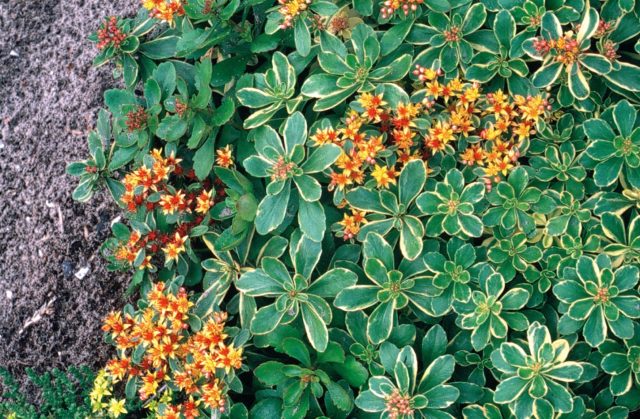
Sedum Kamchatka Variegata blooms in small inflorescences in summer
This variety differs from the others in its ability to form strong straight shoots up to 30 cm high during development. Leaf plates of stonecrop are bright green with denticles along the edges. Each one grows in turn, having only one leaf in the nodes. They have a white or cream border.
Inflorescences are predominantly yellow or orange in color, very small. Flowering occurs in the summer. It is easy to grow Kamchatka sedum - it is completely unpretentious and does not require special care.The culture takes root well on different types of soil, even on rather depleted soil.
Sedum Kamchatka Caramel
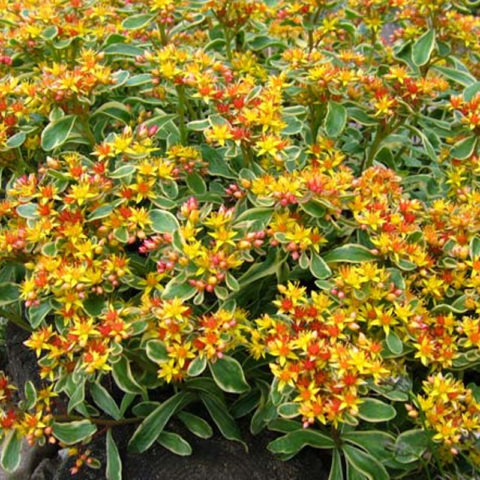
Stonecrop Kamchatka Caramel is formed in height, forming a small bush
It is a perennial plant. It develops in a vertical direction, reaches a height of 20 cm. The leaf plates are elliptical in shape, with notches at the end. The flowers are very small, yellow with an orange core. If the place of growth is sunny, then the leaf at the edges acquires a pink tint. Flowering begins in June and lasts about a month. Growth is moderate, so frequent rejuvenation of the flower is not required. Like many other varieties, Sedum Kamchatka Caramel is successfully grown from seed.
Sedum Tricolor
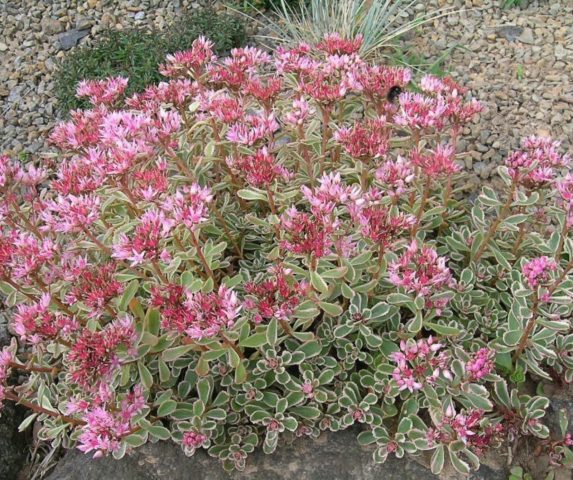
Sedum Tricolor is characterized by abundant flowering of pale pink small inflorescences
This culture is compact in size. The bush is no more than 15 cm high, green leaves with a white or pink border are densely located. The sedum blooms profusely, forming umbellate inflorescences, especially if it grows on the sunny side. Flowering begins in August. The agrotechnics of the bush is very simple. It adapts easily to any soil. It can develop even on rocky terrain.
Due to the triple color, it is appreciated by gardeners, but with an excessively nutrient medium, it can lose its decorative properties by replacing pink flowers with green ones. Does not require frequent watering, which is harmful to the culture.
Sedum Weichenstephaner Gold
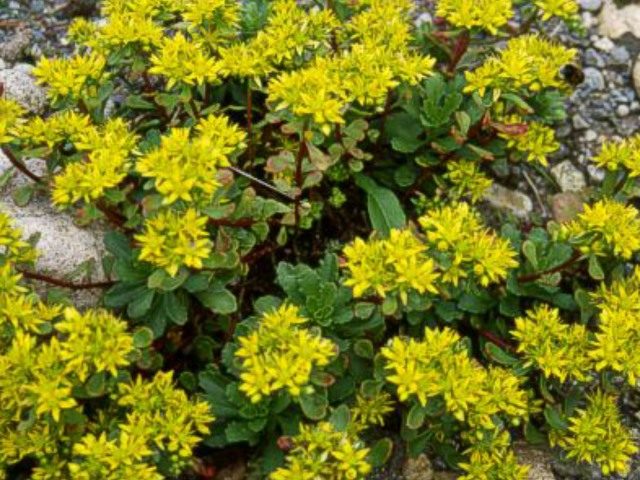
The sedum is popular for its abundant yellow bloom over an extended period.
The culture is a hybrid variety. It is a very hardy plant, grows rapidly and therefore requires rejuvenation every 2-3 years. Attracts gardeners with abundant, lush flowering. The flowers are very small, saturated yellow. The petals are sharp, the inflorescences are in the shape of a star. The leaf plates are curly with notches at the end, a rather dense structure. The stems are raised and weakly branching, they can form a kind of carpet on the ground or a small bush up to 20 cm.
Sedum Ellacombianum
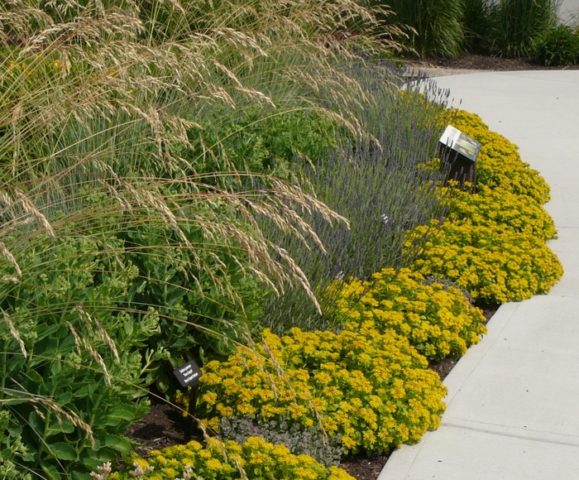
Sedum Ellacombianum blooms profusely, can grow with a rug
This hybrid variety, like many others, belongs to perennials. Its leaves are fleshy, green in color, but in the autumn they change color to burgundy. It is characterized by abundant flowering, which occurs in the first months of summer. The bush is rather low, has a dense structure, usually grows in a hemisphere. The flowers are small, up to 1.5 cm in diameter, the inflorescences of the culture are corymbose. Looks beautiful on slides, in containers, rocky slopes, as the decorative look grows with a rug. For a beautiful flowering, you will need a loose fertile soil.
Sedum Golden Carpet
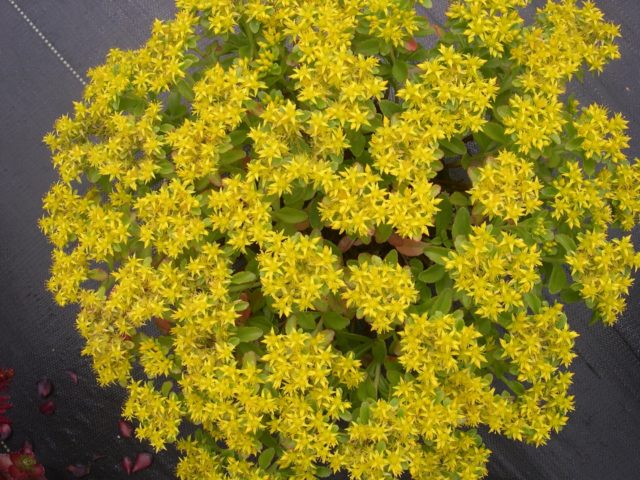
Sedum Golden Carpet attracts gardeners with large inflorescences
This variety is popular among gardeners due to its large, bright yellow inflorescences with a pleasant aroma. Flowering begins in the first month of summer and lasts 25-30 days. Refers to perennials with a thick root system, raised stems up to 30 cm high. The leaf plates are flat, green, with a serrated end. The variety tolerates both humid climate and drought equally well.
Planting and caring for Kamchatka stonecrop
Kamchatka sedum grows well on stony and sandy soils, but it does well on other species. It is important that the soil allows moisture to pass through well, then the plant will grow and bloom profusely. The culture requires a place well lit by the sun. When planting, it is necessary to avoid lowlands where water accumulates. Excessive shading does not affect the culture in the best way - it loses its decorative effect.
Stonecrop should be planted at the end of May, when frosts are unlikely. Landing is done as follows:
- Prepare holes 20 cm deep, 50 cm in diameter.
- Lay drainage at the bottom of each. For this, gravel, pebbles are suitable, you can use broken brick.
- Do not completely fill the well with soil.
- Set up the plant by spreading the roots.
- Sprinkle with soil and water.

The culture can be planted in a pot and decorate the room
At the same time, there should be 20 cm of free space between the plants so that they do not interfere with each other during development and growth.
The most important thing when caring for Kamchatka stonecrop is not to overflow the soil. This has a very negative impact on the culture. Excessive moisture leads to disease. Watering is necessary only after the soil is completely dry. As for adult specimens, they need moisture even less than a young plant.
Sedum is not picky about soil nutrition. It grows even on poor soil. However, if you feed sedum, then no more than 2 times per season - before and after flowering.
Reproduction of stonecrop of Kamchatka
Many people acquire sedum from nurseries, but it can also be propagated by seed, although this is a rather laborious procedure. In addition, gardeners breed sedum by dividing the bush and cuttings. It is worth noting that the division is necessary for an adult perennial to rejuvenate, since otherwise it will lose its decorative appearance. The dug out bush is divided into 4 parts, the root system is poured with activated charcoal, especially the damaged areas, and left in a dark place for several hours. After that, they begin to plant.
Diseases and pests
Only those specimens that are regularly flooded or they grow in a lowland where moisture accumulates are susceptible to diseases. Then they are damaged by rot, which manifests itself in the form of dark spots. In this case, the plant must be treated with the drug, and the affected areas must be cut off with a sharp knife.
Of the insect pests, sedum is susceptible to attack by aphids, weevils, and nematodes. To avoid the death of a plant, it is necessary to inspect it more often, and if insects are found, use special preparations.
Conclusion
Sedum Kamchatka has gained popularity among gardeners due to its decorative appearance, unpretentiousness in care and maintenance. There are quite a few varieties of sedum, mixing them, they make beautiful alpine slides, and, planting them in pots or pots, decorate gazebos.

